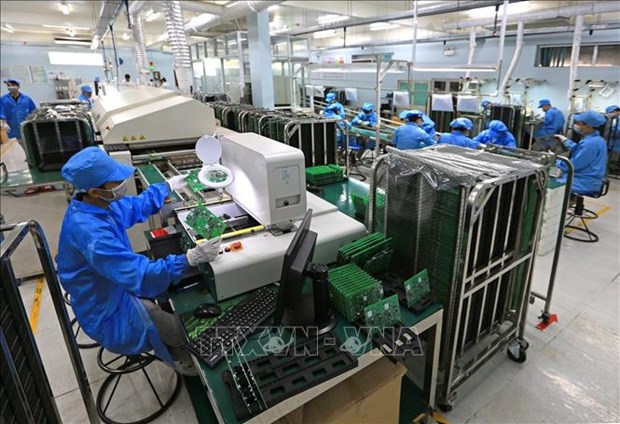Differences of Vietnam’s supply chain analysed
The website Vietnam Briefing run by Dezan Shira & Associates on March 30 posted an article spotlighting Vietnam’s integration into the global value chains (GVCs) and the differences between the supply chain of Vietnam and those of other countries, as well as an overview of the country’s electronics sector.
 Illustrative image (Source: VNA)
Illustrative image (Source: VNA)The article noted that Vietnam has had increasing and steady economic growth of between 6 and 7 percent in the last decade. Its international trade and foreign direct investment (FDI) inflows have been growing and Vietnam has been outpacing its regional peers in this respect. Vietnam is mostly open to investment across sectors. Despite the pandemic, Vietnam is one of the few countries to report positive GDP growth of 2.91 percent in 2020.
Vietnam is a party to several free trade agreements (FTAs) which are push factors that can help it further integrate into GVCs. The ratification of the EU-Vietnam FTA and the upcoming UKVFTA and RCEP will help further its economy propelling its GDP growth, it said.
The article added that the government has launched several incentives to attract investment and encourage Vietnamese businesses to become a part of GVCs. For example, electronic components are entitled to an import tax of 0 percent, while are there additional incentives in income tax for hi-tech projects and investment in industrial zones. Additional incentives in the form of labor and technology policies are also provided by the government.
The government also supports R&D and the development of advanced IT systems as well as the manufacturing of ICT products. This will be a key theme as Vietnam gets more involved in IoT and 5G communications, according to the article.
With proactive participation in GVCs, Vietnam has steadily grown into a prominent manufacturer and exporter for electronics, ranking 12th in the world and third in ASEAN as an exporter for electronics in 2019, it noted.
It held that the electronics industry can be grouped by Harmonized System (HS) codes in three groups. These include finished products that consist of 3Cs – computer, communication and consumer electronics, subassemblies and components which include electronics components. In 2019, the total export value reached 2.5 trillion USD in 2019.
According to the article, Vietnam had strong growth of around 20 percent for electronic finished products surpassing Thailand and just behind the Republic of Korea in export assemblies in 2019.
Vietnam joined GVCs in the late 2000s
and is considered a global tier-2 supplier for 3C products. The top importers for electronics were China, the US, followed by Hong Kong.
The 3Cs finished products group dominates the Vietnamese electronic industry, with communications equipment and consumer electronics leading. While 3Cs dominate Vietnam’s electronics, Vietnam’s role in the global electronics value chains is limited to be an integrator of components, it said.
GVCs can be broken down further into three parts, upstream, midstream, and downstream activities. Vietnam is mainly integrated in the midstream part with lower value add. These include subassemblies, such as displays and special parts, and finished products such as consumer electronics, communications, and computers. Vietnam is also involved in upstream activities but predominantly in low-value added products such as plastic, glass, and packaging.
The article pointed out that Vietnam still needs to do more to integrate into GVCs and faces several challenges in logistics and infrastructure. There is a gap between raw materials and finished goods. The logistics industry is highly fragmented with more than 3,000 logistic companies. These consist of small and medium enterprises providing low-value services. Goods in Vietnam have to go through many intermediaries from raw materials to delivery, increasing transaction costs. In addition, the connection between different modes of transport is weak as well.
Vietnam also lacks the production scale and human infrastructure thus making moving up the value chain challenging, it said, adding that Vietnam’s labor force is also another challenge./.
The 3Cs finished products group dominates the Vietnamese electronic industry, with communications equipment and consumer electronics leading. While 3Cs dominate Vietnam’s electronics, Vietnam’s role in the global electronics value chains is limited to be an integrator of components, it said.
GVCs can be broken down further into three parts, upstream, midstream, and downstream activities. Vietnam is mainly integrated in the midstream part with lower value add. These include subassemblies, such as displays and special parts, and finished products such as consumer electronics, communications, and computers. Vietnam is also involved in upstream activities but predominantly in low-value added products such as plastic, glass, and packaging.
The article pointed out that Vietnam still needs to do more to integrate into GVCs and faces several challenges in logistics and infrastructure. There is a gap between raw materials and finished goods. The logistics industry is highly fragmented with more than 3,000 logistic companies. These consist of small and medium enterprises providing low-value services. Goods in Vietnam have to go through many intermediaries from raw materials to delivery, increasing transaction costs. In addition, the connection between different modes of transport is weak as well.
Vietnam also lacks the production scale and human infrastructure thus making moving up the value chain challenging, it said, adding that Vietnam’s labor force is also another challenge./.













